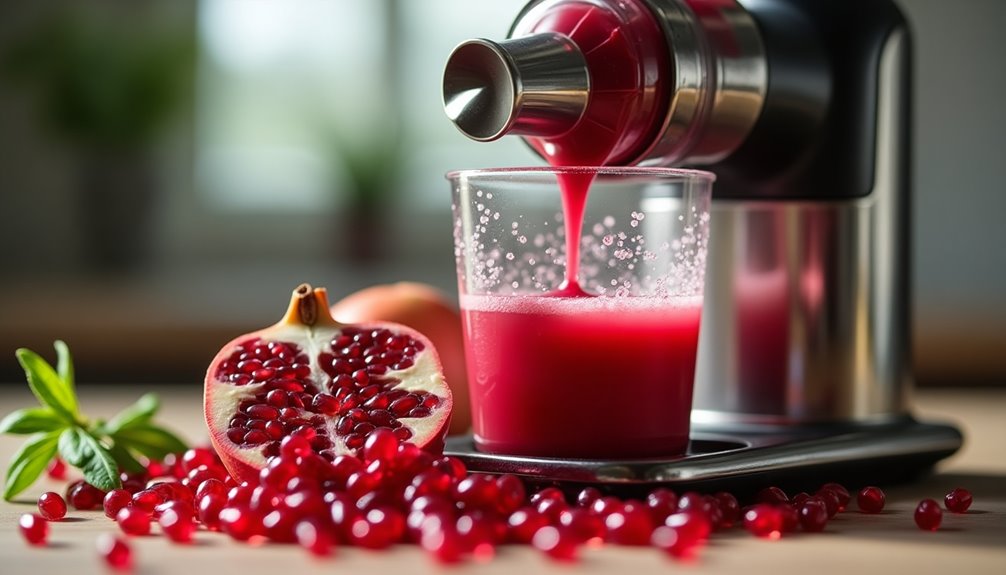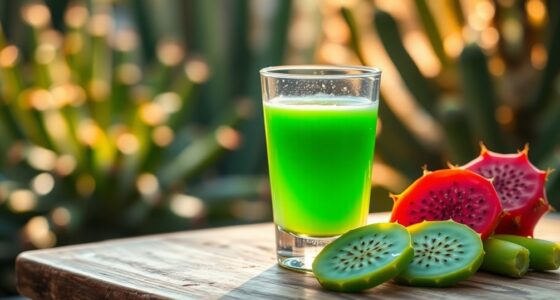To juice a pomegranate in a juicer, start by selecting large, fresh fruits packed with juicy arils. Cut the pomegranate in half and carefully remove the arils, avoiding any bitter membranes. Use a high-speed juicer like Breville to process the arils, ensuring you extract every drop of juice. Strain the juice to remove any pulp for a smoother consistency. Store it in the fridge or freezer, and get ready to enjoy its delicious, tangy flavor in various drinks! More tips await you!
Key Takeaways
- Choose large, fresh pomegranates with juicy arils for optimal flavor and juice yield.
- Cut the pomegranate in half and carefully remove the arils, avoiding any membrane.
- Use a high-speed juicer, like the Breville, to efficiently extract juice from the arils.
- Strain the juice through a double-mesh strainer for a smooth consistency and clear appearance.
- Store the juice in quart-sized containers in the fridge or freezer to maintain freshness.

Juicing a pomegranate can be a rewarding experience, bursting with rich flavor and vibrant color. When you start this journey, you'll want to choose large pomegranates from your local farmers market. These fruits aren't only visually appealing, but they also come packed with juicy arils that promise a delicious and nutritious pomegranate juice.
To get the most out of your pomegranates, it's essential to understand the proper juicing techniques. Begin by cutting the pomegranate in half crosswise. This exposes the juicy arils within, and you'll want to ensure that all the seeds remain intact for optimal juicing. The seeds are the key to extracting that delightful juice.
Using a high-speed juicer, like the Breville dual-speed countertop juicer, can make this process much easier. With an 850-watt motor, this juicer allows you to extract juice quickly and efficiently. Before you toss those arils into the juicer, take a moment to remove them from the skin and separate them from any membrane. This step is crucial, as membranes can impart a bitter taste to your juice.
Once your arils are ready, you can gradually feed them into the juicer. This method ensures that the juicer processes the seeds effectively, yielding the maximum amount of juice. From about four large pomegranates, you can expect to extract around three cups of delicious juice.
After you've juiced the pomegranates, you may find some pulp lingering in your juice. To achieve that smooth consistency you desire, it's important to strain the juice. Use a double-mesh strainer for the best results; this will eliminate any remaining pulp and leave you with a clear, vibrant juice that's ready to enjoy.
Once strained, store your pomegranate juice in quart-sized containers and keep it in the fridge or freezer to maintain freshness. The health benefits of pomegranate juice are well-documented, making it a fantastic addition to your diet. Packed with antioxidants, vitamins, and minerals, drinking freshly juiced pomegranate can boost your immune system and promote heart health.
Plus, the sweet and tangy flavor is a delightful treat on its own or mixed into smoothies and cocktails.
Frequently Asked Questions
Can You Juice Pomegranate in a Nama J2 Juicer?
Yes, you can juice a pomegranate in a Nama J2 juicer!
Just cut the fruit in half and carefully remove the arils. Make sure to use fresh, ripe pomegranates for the best flavor.
Once you've got the arils, place them in the juicer's feed chute. Remember not to include the seeds, as they can make your juice gritty.
Enjoy the nutrient-rich, delicious juice that the Nama J2 extracts effortlessly!
Can You Juice a Pomegranate in a Juicer?
Ever wondered if you can extract that vibrant pomegranate juice using a juicer? Absolutely!
Just slice the pomegranate in half, revealing those juicy arils. Remove the tough outer skin and any spongy bits to avoid bitterness.
A high-speed juicer works wonders, yielding around three cups from four large fruits. If your juicer struggles with pulp, strain the juice for a smoother finish.
Enjoy the tangy, nutritious delight that's packed with vitamins!
Is Pomegranate Juice Good for Type 2?
Yes, pomegranate juice is good for type 2 diabetes.
It's packed with antioxidants that help reduce inflammation and improve insulin sensitivity. Drinking it regularly can lower blood sugar levels and support heart health, which is crucial for managing diabetes.
Plus, its low glycemic index means it won't spike your blood sugar like other high-glycemic foods.
Including pomegranate juice in your diet can be a smart choice for your overall health.
Do You Have to Peel a Pomegranate Before Juicing?
Do you really need to peel a pomegranate before juicing? The good news is, you don't!
Just cut the pomegranate in half to access the juicy seeds inside. Your juicer will extract the delicious juice from those arils while leaving behind the tough outer skin and pith.
Remember to use a juicer that can handle pomegranates' high fiber content, ensuring you get the best flavor and yield.
Enjoy your fresh juice!
Conclusion
Now that you've unlocked the ruby-red treasure of pomegranate juice, let the vibrant elixir dance on your palate. Each sip bursts with sunshine and a hint of tartness, refreshing like a cool breeze on a warm day. You've transformed the fruit's hidden jewels into a delightful drink that's as good for your body as it is for your spirit. So, raise your glass and toast to the delicious journey of juicing—every drop is a celebration of flavor!
Cindy thoroughly researches juicing trends, techniques, and recipes to provide readers with practical advice and inspiration. Her writing style is accessible, engaging, and designed to make complex concepts easy to understand. Cindy’s dedication to promoting the advantages of juicing shines through her work, empowering readers to make positive changes in their lives through the simple act of juicing.











